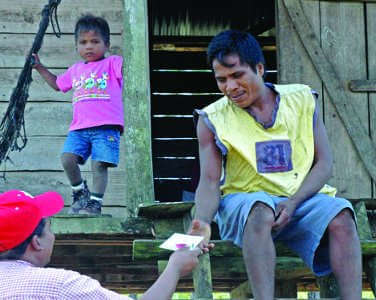
estimated 300 million people last year, according to its recent statistics.
Every Home for Christ (EHC) President Dick Eastman said
in 2009 missionaries distributed gospel booklets to more than 66 million homes, representing roughly 300 million people.
As a result of the outreach, some 12 million people indicated that they made a
decision for Christ or wanted to learn how to do so—up from 10 million in
2009—and 18,000 “Christ Groups,” or house churches, were formed to disciple
those believers.
“It’s really exciting to see what God is doing,” Eastman
said. “I’m incredibly encouraged to realize that a strategy can be so simple.”
Since 1953, EHC missionaries have taken Christian literature
door-to-door in more than 200 nations. In recent decades the ministry has
focused on the 10/40 Window, a region encompassing Africa and most of Asia that
includes the world’s least-evangelized countries.
Eastman says prayer has been key to the response the
ministry has seen in recent years, pointing to the Praying Through the Window campaign that
targeted the 10/40 Window for prayer and evangelism over the last decade. Every
other October, the ministry mobilized intercessors worldwide to pray for that
region throughout the month.
EHC leads ongoing prayer at its Watchman Training Center,
housed at the ministry’s headquarters in Colorado Springs. Internationally it
is developing “walls of prayer,” which are built when intercessors in a
particular area cover all 168 hours in a week with nonstop prayer. More than
1,000 “walls” have been established in Asia alone.
“It’s almost where you can’t keep track of it, it’s
exploding so much,” Eastman said.
“To me [prayer] is the foundation to why we’re seeing such
an increase,” he added, noting that increased financial support has allowed EHC
to expand the number of mobile training centers to marshal more indigenous
missionaries.
Eastman has a goal of reaching 500 million homes in the next
decade, seeing 100 million people respond to the gospel and planting 100,000
Christ Groups.
“Last year we saw 66 million homes [reached], so we know
it’s a doable goal, except that as you get farther and farther
along, it gets harder and harder,” he said. “Generally you reach the easiest-to-reach
places first, then you move into the very hard. There’s hard-to-reach places
because of geography and then there’s very hard places, almost impossible
places, because of ideology, like Islam.”
Still, he’s optimistic about the future. He says the new believers
are proving to be zealous evangelists, and last year’s success shows that the New Testament model of door-to-door
evangelism is “back in fashion.”
“Sure, we have incredible technology today, unbelievable
advantages the early church didn’t have, but I personally believe the same way
the Great Commission began is ultimately the way it’s going to end,” Eastman said.
“Because the people in the most remote villages won’t have a computer or even a
cell phone, and if you’re going to reach them you’ve got to go where they are.”














































